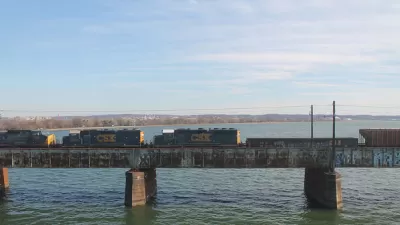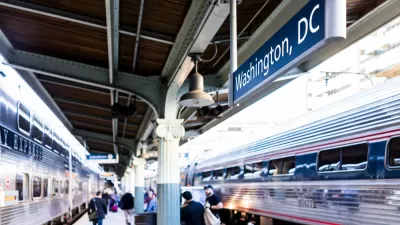A $1.9 billion project to add a second set of rail tracks to the Long Bridge that connects Virginia to D.C. is ready to move forward with a recently completed Environmental Impact Statement.

"With the state budget in tatters and commuter levels at record lows, now might hardly seem the right moment for Virginia to embark upon a $1.9 billion rail project. However, the recent conclusion of the Long Bridge’s environmental impact study has cleared the way for the commonwealth to do just that," reports Wyatt Gordon.
Rail advocates and enthusiasts have been touting the potential impact of the Long Bridge project since the Draft EIS for the Long Bridge project was completed in September. But that enthusiasm increased in December 2019, when Virginia announced a $3.7 billion deal to buy 225 miles of track from CSX. This latest announcement about the completion of the EIS shows that Virginia's intercity rail ambitions are maintaining momentum through the economic fallout of the pandemic.
Wyatt reports that funding contingencies remain for the Long Bridge project to come to its anticipated fruition. "Although the final funding agreement is still being worked out among Amtrak, the D.C. Department of Transportation and Virginia’s Department of Rail and Public Transportation, DRPT Director Jennifer Mitchell isn’t worried about Amtrak’s promised $944 million contribution or the fate of the Long Bridge project."
The final project will be worth the anticipation expressed by Virginia transportation officials in the article. When complete, the project will double the rail capacity across the Potomac River, "thereby creating new possibilities of D.C. to RVA high speed rail, expanded Virginia Rail Express commuter service and increased freight from the Port of Virginia," according to Wyatt.
FULL STORY: Long Bridge rail project barrels forward full speed ahead

Study: Maui’s Plan to Convert Vacation Rentals to Long-Term Housing Could Cause Nearly $1 Billion Economic Loss
The plan would reduce visitor accommodation by 25,% resulting in 1,900 jobs lost.

North Texas Transit Leaders Tout Benefits of TOD for Growing Region
At a summit focused on transit-oriented development, policymakers discussed how North Texas’ expanded light rail system can serve as a tool for economic growth.

Why Should We Subsidize Public Transportation?
Many public transit agencies face financial stress due to rising costs, declining fare revenue, and declining subsidies. Transit advocates must provide a strong business case for increasing public transit funding.

How to Make US Trains Faster
Changes to boarding platforms and a switch to electric trains could improve U.S. passenger rail service without the added cost of high-speed rail.

Columbia’s Revitalized ‘Loop’ Is a Hub for Local Entrepreneurs
A focus on small businesses is helping a commercial corridor in Columbia, Missouri thrive.

Invasive Insect Threatens Minnesota’s Ash Forests
The Emerald Ash Borer is a rapidly spreading invasive pest threatening Minnesota’s ash trees, and homeowners are encouraged to plant diverse replacement species, avoid moving ash firewood, and monitor for signs of infestation.
Urban Design for Planners 1: Software Tools
This six-course series explores essential urban design concepts using open source software and equips planners with the tools they need to participate fully in the urban design process.
Planning for Universal Design
Learn the tools for implementing Universal Design in planning regulations.
Ascent Environmental
Borough of Carlisle
Institute for Housing and Urban Development Studies (IHS)
City of Grandview
Harvard GSD Executive Education
Toledo-Lucas County Plan Commissions
Salt Lake City
NYU Wagner Graduate School of Public Service




























